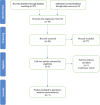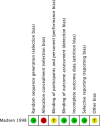Cephalo-medullary nailing versus dynamic hip screw with trochanteric stabilisation plate for the treatment of unstable per-trochanteric hip fractures: a meta-analysis
- PMID: 33430910
- PMCID: PMC7802196
- DOI: 10.1186/s13018-020-02193-5
Cephalo-medullary nailing versus dynamic hip screw with trochanteric stabilisation plate for the treatment of unstable per-trochanteric hip fractures: a meta-analysis
Abstract
Background: The use of cephalo-medullary nails (CMN) is a widely accepted management option for the treatment of unstable per-trochanteric hip fractures. A growing body of literature has reported good functional and radiological outcomes in patients managed with a dynamic hip screw supplemented with a trochanteric stabilisation plate (DHS w/ TSP). However, a robust meta-analysis does not exist in the current literature comparing the two fixation methods.
Purposes: Management of these kinds of injuries is very challenging in orthopaedic practice, yet no strong evidence is in place to delineate which implant gives the best results. This meta-analysis is the first to determine the efficacy of CMN versus DHS w/ TSP.
Methods: An up-to-date literature search was performed using a predetermined search strategy and eligibility criteria. All suitable literature was appraised for methodological quality using the Cochrane's collaboration tool. Hospital stay, operative time, intra-operative complication rate, mechanical failure rate, infection rates, revision rates and functional outcomes were all considered.
Results: A total of five studies were included in the meta-analysis. The results of this analysis suggest that CMN is only associated with lower revision rates when compared to DHS w/ TSP; however, no significant difference was found in terms of hospital stay, operative time, blood transfusion, complications rate and functional outcome.
Conclusion: Both CMN and DHS w/TSP proved to be reliable in the management of unstable per-trochanteric fractures; however, more extensive datasets are required to draw robust conclusions.
Keywords: Cephalo-medullary nail; Dynamic hip screw; Hip fractures; Trochanteric stabilisation plate; Unstable trochanteric fractures.
Conflict of interest statement
The authors declare that they have no competing interests.
Figures





Similar articles
-
Dynamic hip screw with trochanteric stabilizing plate in the treatment of unstable proximal femoral fractures: a comparative study with the Gamma nail and compression hip screw.J Orthop Trauma. 1998 May;12(4):241-8. doi: 10.1097/00005131-199805000-00005. J Orthop Trauma. 1998. PMID: 9619458 Clinical Trial.
-
Functional and radiological outcomes of dynamic hip screw with trochanteric stabilizing plate versus short proximal femoral nail in management of unstable trochanteric fractures: A randomized-controlled trial.Jt Dis Relat Surg. 2022;33(3):531-537. doi: 10.52312/jdrs.2022.800. Jt Dis Relat Surg. 2022. PMID: 36345180 Free PMC article. Clinical Trial.
-
[Stabilisation of unstable trochanteric femoral fractures. Dynamic hip screw (DHS) with trochanteric stabilisation plate vs. proximal femur nail (PFN)].Unfallchirurg. 2003 Jan;106(1):39-47. doi: 10.1007/s00113-002-0476-6. Unfallchirurg. 2003. PMID: 12552392 German.
-
Comparative effectiveness research on proximal femoral nail versus dynamic hip screw in patients with trochanteric fractures: a systematic review and meta-analysis of randomized trials.J Orthop Surg Res. 2022 Jun 3;17(1):292. doi: 10.1186/s13018-022-03189-z. J Orthop Surg Res. 2022. PMID: 35658909 Free PMC article.
-
Lateral femoral wall thickness in trochanteric hip fractures: a systematic review.Hip Int. 2024 Sep;34(5):668-676. doi: 10.1177/11207000241267708. Epub 2024 Aug 26. Hip Int. 2024. PMID: 39183629
Cited by
-
Poor usability of computer-assisted navigation for hip fracture surgery.Arch Orthop Trauma Surg. 2024 Jan;144(1):251-257. doi: 10.1007/s00402-023-05096-2. Epub 2023 Oct 25. Arch Orthop Trauma Surg. 2024. PMID: 37878075 Free PMC article.
-
Does intramedullary nail have advantages over dynamic hip screw for the treatment of AO/OTA31A1-A3? A meta-analysis.BMC Musculoskelet Disord. 2023 Jul 18;24(1):588. doi: 10.1186/s12891-023-06715-0. BMC Musculoskelet Disord. 2023. PMID: 37464358 Free PMC article.
-
A combined fracture and mortality risk index useful for treatment stratification in hip fragility fractures.Jt Dis Relat Surg. 2021;32(3):583-589. doi: 10.52312/jdrs.2021.382. Epub 2021 Nov 19. Jt Dis Relat Surg. 2021. PMID: 34842088 Free PMC article.
-
Evaluation of a Blood Reserve Protocol for Hip Fracture Surgery in the Elderly.Rev Bras Ortop (Sao Paulo). 2024 Sep 4;59(4):e617-e621. doi: 10.1055/s-0044-1785520. eCollection 2024 Aug. Rev Bras Ortop (Sao Paulo). 2024. PMID: 39239586 Free PMC article.
-
Angle-Adjustable Dynamic Hip Screw Plate for Unstable Trochanteric Fractures in Middle-Aged Patients: Mid-Term Outcomes and Return to Sport.J Clin Med. 2024 Feb 8;13(4):988. doi: 10.3390/jcm13040988. J Clin Med. 2024. PMID: 38398302 Free PMC article.
References
Publication types
MeSH terms
LinkOut - more resources
Full Text Sources
Other Literature Sources
Medical
Miscellaneous

